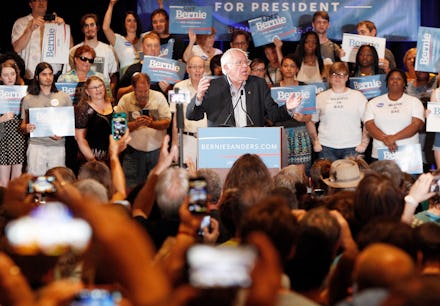One Chart Shows Just How Impressive Bernie Sanders' Massive Crowds Really Are

Everything is bigger in Texas, and Bernie Sanders' crowds are no exception. The Democratic presidential candidate from Vermont, whose underdog campaign has turned him into a folk hero among progressives, capped off an up-and-down weekend by hosting 5,000 supporters at a rally in Houston on Sunday night. Hours earlier, in Dallas, the crowd count came in at around 8,000.
Sanders' formidable showing in the Lone Star State followed a raucous Saturday event in Phoenix that drew an estimated 11,000 people, or about double the number who actually turned up for Donald Trump's appearance a week earlier.
At this early stage of the campaign — still more than six months out from the first contest — large audiences mean a better chance to sign up future donors and build up an infrastructure in states where, at least in the primary, Sanders has a real opportunity to win significant numbers.
Below is a breakdown of how Sanders' largest events compare to the biggest crowds for the rest of the 2016 candidates. Crowd size is an imperfect science, but we're drawing upon news stories at the time citing event and campaign officials' best estimates. (You can find details and sources in this spreadsheet.) For every candidate except Sanders and Trump, the largest rally was a campaign kickoff event. Also to note: the mostly student audience for Sen. Ted Cruz' (R-Texas) launch at Liberty University was compelled to attend as part of the school's weekly mandatory convocation gathering:
What it means: While Sanders ability to attract huge crowds is a key narrative of the campaign so far, crowd size is a notoriously imperfect indicator of a candidate's prospects in a coming election. In the days leading up to the 2012 presidential election, Republican nominee Mitt Romney played to roaring crowds in a number of states, including Ohio. On Election Day, he would lose there by more than 100,000 votes.
Some campaigns are purposefully eschewing large venues, hoping to connect to voters in smaller, more intimate settings. Hillary Clinton's campaign has made a point of hosting relatively small events and roundtables with voters — her largest rally to date was her campaign launch on Roosevelt Island in New York, after weeks of small get-togethers with caucus-goers and voters in Iowa and New Hampshire.
For Sanders, though, the calculus is much different. He is seeking to build a national movement. Large turnout has a number of pragmatic values, like juicing up his email lists and forcing the Clinton-obsessed pundit class to keep an eye on where he goes — and what he is saying there.